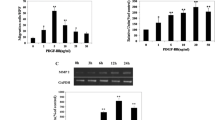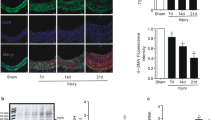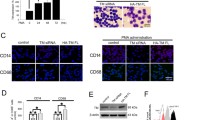Abstract
Monocyte chemoattractant protein-1 (MCP-1) is an inflammatory chemokine that promotes atherosclerosis and is a mediator of the response to arterial injury. We previously demonstrated that platelet-derived growth factor (PDGF) and angiotensin II (Ang) induce the accumulation of MCP-1 mRNA in vascular smooth muscle cells mainly by increasing mRNA stability. In the present study, we have examined the signaling pathways involved in this stabilization of MCP-1 mRNA. The effect of PDGF (BB isoform) and Ang on MCP-1 mRNA stability was mediated by the PDGF β and angiotensin II receptor AT1R, respectively, and did not involve transactivation between the two receptors. The effect of PDGF-BB was blocked by inhibitors of protein kinase C (PKC), but not by inhibitors of phosphoinositol 3-kinase (PI3K), Src, or NADPH oxidase (NADPHox). In contrast, the effect of Ang was blocked by inhibitors of Src, and PKC, but not by inhibitors of PI3 K, or NADPHox. The effect of PDGF BB on MCP-1 mRNA stability was blocked by siRNA directed against PKCδ and protein kinase D (PKD), whereas the effect of Ang was blocked only by siRNA directed against PKCδ. These results suggest that the enhancement of MCP-1 mRNA stability by PDGF-BB and Ang are mediated by distinct “proximal” signaling pathways that converge on activation of PKCδ. This study identifies a novel role for PKCδ in mediating mRNA stability in smooth muscle cells.





Similar content being viewed by others
References
DeVries ME, Ran L, Kelvin DJ (1999) On the edge: the physiological and pathophysiological role of chemokines during inflammatory and immunological responses. Semin Immunol 11:95–104
MacDermott RP (1999) Chemokines in the inflammatory bowel diseases. J Clin Immunol 19:266–272
Panzer U, Stahl RA (1999) Chemokines and renal inflammation. Nephrologie 20:335–341
Taubman MB, Rollins BJ, Poon M, Marmur J, Green RS, Berk BC, Nadal-Ginard B (1992) JE mRNA accumulates rapidly in aortic injury and in platelet-derived growth factor-stimulated vascular smooth muscle cells. Circ Res 70:314–325
Yla-Herttuala S, Lipton BA, Rosenfeld ME, Sarkioja T, Yoshimura T, Leonard EJ, Witztum JL, Steinberg D (1991) Expression of monocyte chemoattractant protein 1 in macrophage-rich areas of human and rabbit atherosclerotic lesions. Proc Natl Acad Sci USA 88:5252–5256
Yu X, Dluz S, Graves DT, Zhang L, Antoniades HN, Hollander W, Prusty S, Valente AJ, Schwartz CJ, Sonenshein GE (1992) Elevated expression of monocyte chemoattractant protein 1 by vascular smooth muscle cells in hypercholesterolemic primates. Proc Natl Acad Sci USA 89:6953–6957
Aiello RJ, Bourassa PA, Lindsey S, Weng W, Natoli E, Rollins BJ, Milos PM (1999) Monocyte chemoattractant protein-1 accelerates atherosclerosis in apolipoprotein E-deficient mice. Arterioscler Thromb Vasc Biol 19:1518–1525
Boring L, Gosling J, Cleary M, Charo IF (1998) Decreased lesion formation in CCR2−/− mice reveals a role for chemokines in the initiation of atherosclerosis. Nature 394:894–897
Gosling J, Slaymaker S, Gu L, Tseng S, Zlot CH, Young SG, Rollins BJ, Charo IF (1999) MCP-1 deficiency reduces susceptibility to atherosclerosis in mice that overexpress human apolipoprotein B. J Clin Invest 103:773–778
Gu L, Okada Y, Clinton SK, Gerard C, Sukhova GK, Libby P, Rollins BJ (1998) Absence of monocyte chemoattractant protein-1 reduces atherosclerosis in low density lipoprotein receptor-deficient mice. Mol Cell 2:275–281
Kim WJH, Chereshnev I, Gazdoiu M, Fallon JT, Rollins BJ, Taubman MB (2003) MCP-1 deficiency is associated with reduced intimal hyperplasia after arterial injury. Biochem Biophys Res Commun 310:936–942
Roque M, Kim WJ, Gazdoin M, Malik A, Reis ED, Fallon JT, Badimon JJ, Charo IF, Taubman MB (2002) CCR2 deficiency decreases intimal hyperplasia after arterial injury. Arterioscler Thromb Vasc Biol 22:554–559
Furukawa Y, Matsumori A, Ohashi N, Shioi T, Ono K, Harada A, Matsushima K, Sasayama S (1999) Anti-monocyte chemoattractant protein-1/monocyte chemotactic and activating factor antibody inhibits neointimal hyperplasia in injured rat carotid arteries. Circ Res 84:306–314
Andrae J, Gallini R, Betsholtz C (2008) Role of platelet-derived growth factors in physiology and medicine. Genes Dev 22:1276–1312
Raines EW (2004) PDGF and cardiovascular disease. Cytokine Growth Factor Rev 15:237–254
Giese NA, Marijianowski MM, McCook O, Hancock A, Ramakrishnan V, Fretto LJ, Chen C, Kelly AB, Koziol JA, Wilcox JN, Hanson SR (1999) The role of alpha and beta platelet-derived growth factor receptor in the vascular response to injury in nonhuman primates. Arterioscler Thromb Vasc Biol 19:900–909
Hart CE, Kraiss LW, Vergel S, Gilbertson D, Kenagy R, Kirkman T, Crandall DL, Tickle S, Finney H, Yarranton G, Clowes AW (1999) PDGFbeta receptor blockade inhibits intimal hyperplasia in the baboon. Circulation 99:564–569
Ferns GA, Raines EW, Sprugel KH, Motani AS, Reidy MA, Ross R (1991) Inhibition of neointimal smooth muscle accumulation after angioplasty by an antibody to PDGF. Science 253:1129–1132
Banai S, Wolf Y, Golomb G, Pearle A, Waltenberger J, Fishbein I, Schneider A, Gazit A, Perez L, Huber R, Lazarovichi G, Rabinovich L, Levitzki A, Gertz SD (1998) PDGF-receptor tyrosine kinase blocker AG1295 selectively attenuates smooth muscle cell growth in vitro and reduces neointimal formation after balloon angioplasty in swine. Circulation 97:1960–1969
Yamasaki Y, Miyoshi K, Oda N, Watanabe M, Miyake H, Chan J, Wang X, Sun L, Tang C, McMahon G, Lipson KE (2001) Weekly dosing with the platelet-derived growth factor receptor tyrosine kinase inhibitor SU9518 significantly inhibits arterial stenosis. Circ Res 88:630–636
Nabel EG, Yang Z, Liptay S, San H, Gordon D, Haudenschild CC, Nabel GJ (1993) Recombinant platelet-derived growth factor B gene expression in porcine arteries induce intimal hyperplasia in vivo. J Clin Invest 91:1822–1829
Poon M, Hsu WC, Bogadanov VY, Taubman MB (1996) Secretion of monocyte chemotactic activity by cultured rat aortic smooth muscle cells in response to PDGF is due predominantly to the induction of JE/MCP-1. Am J Pathol 149:307–317
Liu B, Poon M, Taubman MB (2006) PDGF-BB enhances monocyte chemoattractant protein-1 mRNA stability in smooth muscle cells by downregulating ribonuclease activity. J Mol Cell Cardiol 41:160–169
Dzau VJ (2001) Theodore cooper lecture: tissue angiotensin and pathobiology of vascular disease: a unifying hypothesis. Hypertension 37:1047–1052
Mehta PK, Griendling KK (2007) Angiotensin II cell signaling: physiological and pathological effects in the cardiovascular system. Am J Physiol Cell Physiol 292:C82–C97
de Gasparo M, Catt KJ, Inagami T, Wright JW, Unger T (2000) International union of pharmacology. XXIII. The angiotensin II receptors. Pharmacol Rev 52:415–472
Steckelings UM, Kaschina E, Unger T (2005) The AT2 receptor—a matter of love and hate. Peptides 26:1401–1409
Daugherty A, Cassis L (2004) Angiotensin II-mediated development of vascular diseases. Trends Cardiovasc Med 14:117–120
Ishibashi M, Egashira K, Zhao Q, Hiasa K, Ohtani K, Ihara Y, Charo IF, Kura S, Tsuzuki T, Takeshita A, Sunagawa K (2004) Bone marrow-derived monocyte chemoattractant protein-1 receptor CCR2 is critical in angiotensin II-induced acceleration of atherosclerosis and aneurysm formation in hypercholesterolemic mice. Arterioscler Thromb Vasc Biol 24:e174–e178
Fu J, Menzies K, Freeman RS, Taubman MB (2007) EGLN3 prolyl hydroxylase regulates skeletal muscle differentiation and myogenin protein stability. J Biol Chem 282:12410–12418
Poon M, Liu B, Taubman MB (1999) Identification of a novel dexamethasone-sensitive RNA-destabilizing region on rat monocyte chemoattractant protein 1 mRNA. Mol Cell Biol 19:6471–6478
Doller A, Akool E-S, Huwiler A, Muller R, Radeke HH, Pfeilschifter J, Eberhardt W (2008) Posttranslational modification of the AU-rich element binding protein HuR by protein kinase Cdelta elicits angiotensin II-induced stabilization and nuclear export of cyclooxygenase 2 mRNA. Mol Cell Biol 28:2608–2625
Heldin CH, Ostman A, Ronnstrand L (1998) Signal transduction via platelet-derived growth factor receptors. Biochim Biophys Acta 1378:F79–F113
Higuchi S, Ohtsu H, Suzuki H, Shirai H, Frank GD, Eguchi S (2007) Angiotensin II signal transduction through the AT1 receptor: novel insights into mechanisms and pathophysiology. Clin Sci (Lond) 112:417–428
Millette E, Rauch BH, Kenagy RD, Daum G, Clowes AW (2006) Platelet-derived growth factor-BB transactivates the fibroblast growth factor receptor to induce proliferation in human smooth muscle cells. Trends Cardiovasc Med 16:25–28
Yin G, Yan C, Berk BC (2003) Angiotensin II signaling pathways mediated by tyrosine kinases. Int J Biochem Cell Biol 35:780–783
Hollenbeck ST, Itoh H, Louie O, Faries PL, Liu B, Kent KC (2004) Type I collagen synergistically enhances PDGF-induced smooth muscle cell proliferation through pp60src-dependent crosstalk between the alpha2beta1 integrin and PDGFbeta receptor. Biochem Biophys Res Commun 325:328–337
Mackay HJ, Twelves CJ (2007) Targeting the protein kinase C family: are we there yet? Nat Rev Cancer 7:554–562
Glisovic T, Bachorik JL, Yong J, Dreyfuss G (2008) RNA-binding proteins and post-transcriptional gene regulation. FEBS Lett 582:1977–1986
Tourriere H, Chebli K, Tazi J (2002) mRNA degradation machines in eukaryotic cells. Biochimie 84:821–837
Carpenter L, Cordery D, Biden TJ (2001) Protein kinase Cdelta activation by interleukin-1beta stabilizes inducible nitric-oxide synthase mRNA in pancreatic beta-cells. J Biol Chem 276:5368–5374
Dean JL, Sully G, Clark AR, Saklatvala J (2004) The involvement of AU-rich element-binding proteins in p38 mitogen-activated protein kinase pathway-mediated mRNA stabilisation. Cell Signal 16:1113–1121
Bornfeldt KE, Raines EW, Graves LM, Skinner MP, Krebs EG, Ross R (1995) Platelet-derived growth factor. Distinct signal transduction pathways associated with migration versus proliferation. Ann N Y Acad Sci 766:416–430
Meloche S, Landry J, Huot J, Marceau F, Giasson E (2000) p38 MAP kinase pathway regulates angiotensin II-induced contraction of rat vascular smooth muscle. Am J Physiol Heart Circ Physiol 279:H741–H751
Acknowledgments
This study was supported by a grant from the National Institutes of Health Grant P01 HL77789 (MBT) and an American Heart Association Northeast Postdoctoral Fellowship (LD).
Author information
Authors and Affiliations
Corresponding author
Rights and permissions
About this article
Cite this article
Liu, B., Dhawan, L., Blaxall, B.C. et al. Protein kinase Cδ mediates MCP-1 mRNA stabilization in vascular smooth muscle cells. Mol Cell Biochem 344, 73–79 (2010). https://doi.org/10.1007/s11010-010-0530-6
Received:
Accepted:
Published:
Issue Date:
DOI: https://doi.org/10.1007/s11010-010-0530-6




